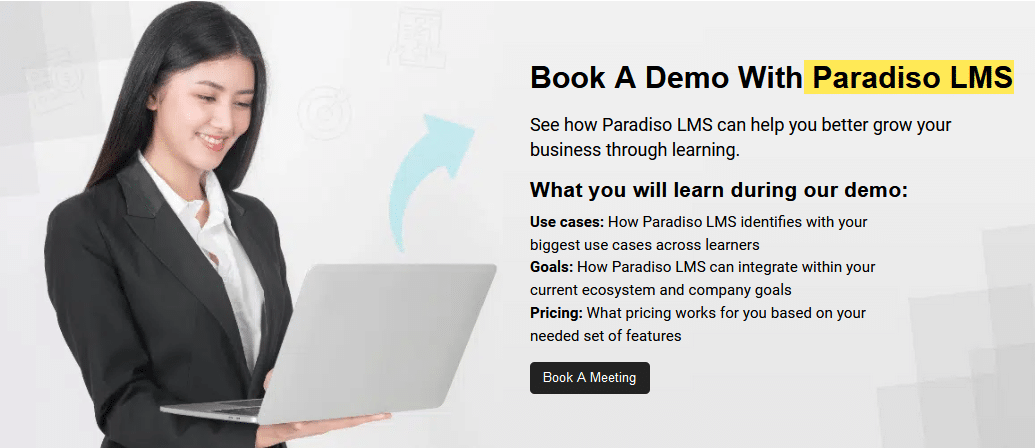It is impossible to overstate the significance of compliance training because businesses must follow all applicable rules and regulations. Effective compliance training reduces risks, protects the company’s reputation, and ensures no needless legal disputes or penalties arise. Organizations must ensure that employees understand and adhere to laws, regulations, and internal policies.
9 Tips to Effective Compliance Training with an LMS

70% of corporate risk and compliance professionals said they have noticed a shift from check-the-box compliance to a more strategic approach over the past two to three years. (2023 Thomson Reuters Risk & Compliance Survey Report).
Leveraging a Learning Management System (LMS) for compliance training offers a structured and scalable solution to deliver consistent and up-to-date content. An LMS allows companies to streamline the training process, track employee progress, and ensure that all staff members receive the necessary instruction, regardless of their location. This digital approach not only saves time and resources but also provides a more engaging and interactive learning experience through multimedia content, quizzes, and assessments.
How To Achieve Engaging and Effective Compliance Training
You must follow the rules governing your industry, and fortunately, most businesses recognize the value of compliance-related training. A 2015 research, by Brandon Hall Group, revealed that 49% of the organizations surveyed considered compliance training a priority critical to their business.
Achieving engaging and effective compliance training requires a combination of strategic planning, engaging content, and leveraging the right technology. Here are some key steps to ensure your compliance training program is both effective and engaging:
1. Understand Regulatory Requirements
- Identify Specific Needs: Understand the legal and regulatory requirements relevant to your industry.
- Consult Experts: Work with legal experts to ensure that your training content is accurate and comprehensive.
2. Leverage a Learning Management System (LMS)
- Centralized Platform: Use an LMS to deliver, track, and manage training.
- Automation: Automate notifications for training deadlines, renewals, and updates.
- Analytics and Reporting: Utilize built-in reporting tools to monitor progress and compliance status.
3. Create Engaging Content
- Multimedia Elements: Use videos, animations, and infographics to make content more engaging.
- Interactive Modules: Incorporate quizzes, simulations, and case studies to reinforce learning.
- Real-World Scenarios: Use examples and scenarios that employees might encounter in their roles.
- Tailored Content: Customize training to different roles and departments within the organization.
- Flexible Learning Paths: Allow employees to learn at their own pace and revisit content as needed.
5. Foster a Culture of Continuous Learning
- Regular Updates: Keep content current with the latest regulations and industry practices.
- Ongoing Training: Provide continuous education opportunities beyond mandatory compliance training.
- Encourage Feedback: Solicit feedback from employees to improve training programs continuously.
6. Measure and Improve
- Track Performance: Use LMS analytics to track completion rates, assessment scores, and engagement levels.
- Evaluate Effectiveness: Assess the impact of training on compliance and behavior change.
- Refine Content: Update and refine training materials based on feedback and performance data.
Insider Tips To Choose The Perfect Learning Management System
Download now to get insider tips on choosing the perfect Learning Management System!

Here’s a look at 9 tips to an effective Compliance Training with an LMS
Using a Learning Management System (LMS) to create efficient compliance training is crucial to ensuring that employees comprehend and follow important rules and guidelines. By utilizing an LMS’s capabilities, organizations may provide consistent, interesting, and conveniently available training content.
Here are some key tips to enhance your compliance training program, making it both effective and engaging for your workforce.
1. Use a Variety of Multimedia and Learning Elements
Since everyone has a distinct learning curve, organizations must keep in mind that not every employee can receive the same level of training. Incorporating a variety of multimedia and educational components in the compliance training plan, such as vibrant visuals, audio clips, interactivities, and other features, such as e-learning courses, PDFs, PPTs, Videos, and infographics, helps break up the monotony of learning and infuse new life into the training regimen.
2. Take Advantage of Mobile Learning
Thanks to mobile learning, employees can receive compliance training anytime, anywhere, which is a blessing for the program. Employees can even smoothly transition between devices and continue their learning on whichever device they choose, thanks to a responsive learning management system (LMS).
3. Make your LMS a One-stop shop for all things ‘Compliance’
With just one click, an LMS can be transformed into an archive for training materials, competencies, certificates, and more, available whenever and wherever needed. Comparable to a centralized data storage system, it provides an overview of each trainee’s past performance, status, and upcoming compliance training plans. Additionally, it guarantees that a person does not need to retake a course if they have already completed it. Employees who bring compliance certificates from other organizations will find this very handy.
4. Assess your Learners
Enrolling your staff in educational materials is only half the battle won. It’s also critical to evaluate their comprehension of the instruction and topic matter. Organizations can assign various assessments and assignments to their staff by using an LMS with excellent assessment features.
5. Make it a Two-way Street
Learners have the chance to express their ideas and concerns through online polls, questionnaires, and surveys. Information can be gathered fast, patterns may be seen, and problem areas can be found. Employee opinions and sentiments can be gleaned through surveys and polls, which can be a great way to find the advantages and disadvantages of the existing training approach.
6. Track, Report and take Intelligent Decisions
The tracking and reporting capabilities of an LMS program are an additional advantage. Reporting is made very easy with an LMS since it allows one to create a report to track and monitor employee progress. By converting this data into usable information, processes and L&D strategies can be improved.
7. Don’t Rely on your Learners’ Memory Alone
Employees may need to retake some training courses after a predetermined time to continue receiving certification. An LMS can send students reminders to ensure they return and recertify on time. Because employees can receive automatic reminders rather than human messages from relevant departments, this feature is incredibly helpful. Not only is it useful for retaking classes, but it also helps students manage their time by sending out notifications and reminders.
8. Make it ‘Social’
Collaborative learning enables staff members to collaborate with educators to enhance learning through social contact. Most crucially, learning can occur in an informal atmosphere through social media. The key is how businesses use social media meaningfully to promote knowledge sharing and exchanging ideas. Social media can also be an effective tool for collaborative or social learning. Numerous social media platforms facilitate cooperative work, enabling individuals to hone their teamwork abilities.
9. Keep them ‘Compliant’. Always!
To progress in the workforce, several industries require ongoing education or additional retraining. Setting up an LMS is a simple approach to guarantee that managers and staff consistently adhere to compliance standards. Supervisors can delineate the career path for every role in the organization, providing staff with clear knowledge of the requirements and the frequency of retraining sessions necessary to maintain compliance.
Conclusion
Companies can guarantee that their employees stay knowledgeable and compliant by utilizing an LMS’s automation, analytics, and personalized learning paths, among other capabilities. Purchasing an efficient learning management system (LMS) for effective compliance training reduces risks and promotes a culture of ongoing accountability and learning, which eventually improves the company’s success and integrity.
Effective compliance training with a Learning Management System (LMS) empowers organizations to maintain high standards of regulatory adherence while engaging employees through interactive and accessible content. Paradiso LMS stands out as one of the best platforms for compliance training, offering robust features such as automation, detailed analytics, and customizable learning paths.
By leveraging Paradiso LMS, companies can ensure their workforce remains informed and compliant, mitigating risks and fostering a culture of continuous learning and accountability. Investing in Paradiso LMS for compliance training not only streamlines the process but also enhances overall organizational success and integrity. This will become clearer with a free demo.












